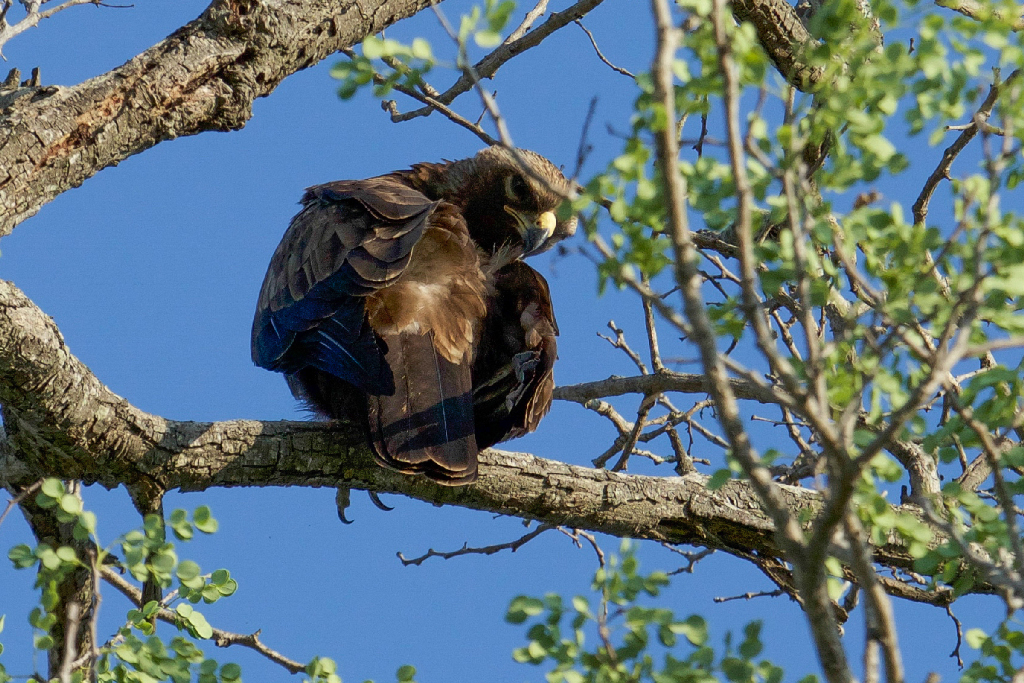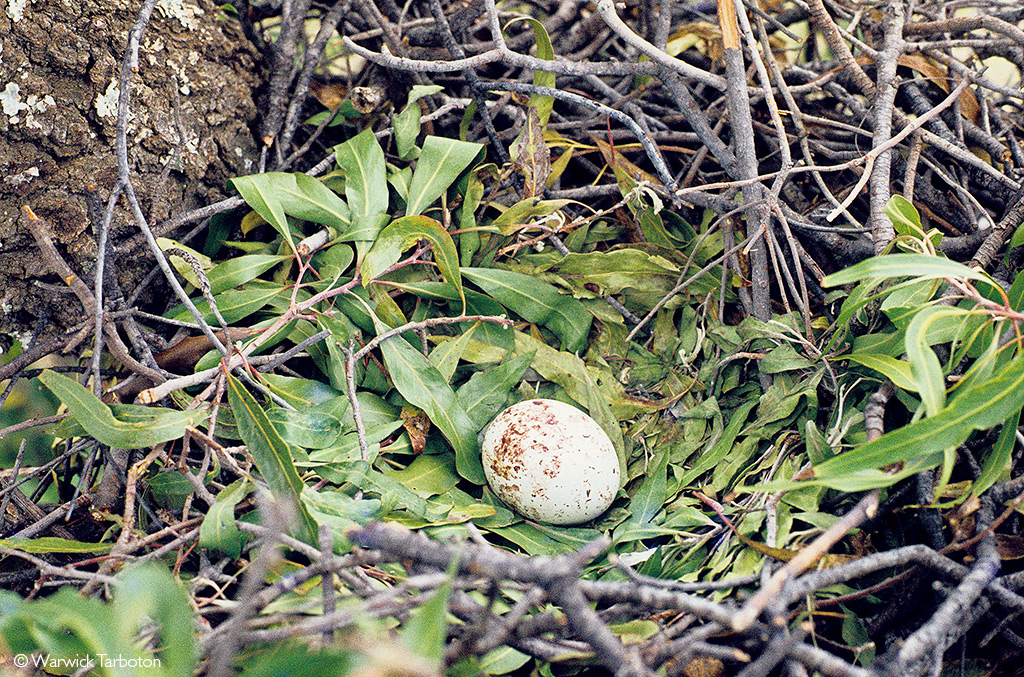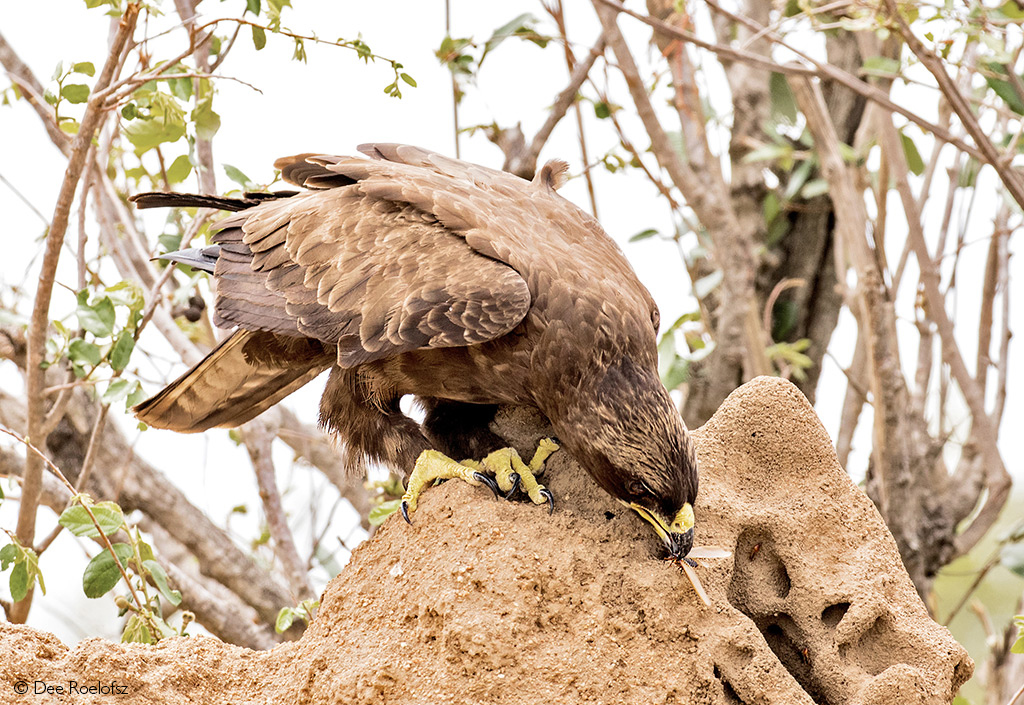
Why does the Wahlberg’s eagle lay only one egg? Most other eagles in their genus (Aquila) lay a second egg as a type of insurance policy – and in most cases, the second fledgling is killed through siblicide. The answer to the Wahlberg’s unique parenting style is fascinating…
The hard truth about birds in the nest
Most eagle chicks in the Aquila genus are ‘siblicidal’. This means that siblings fight each other to the point of death. The chicks are fiercely competitive for the food brought to the nest by the parents, and often, the bigger chick in the nest kills the smaller one, either through monopolising the food or pecking the younger sibling to the point where it is too cowed to move or beg and starves. So, what are the possible (evolutionary) reasons for this?
Dr Rob Simmons has always been fascinated by eagles. He became particularly interested in why some eagle species laid two eggs yet only ever rear one chick (because of siblicide). Why not just lay one egg? There has long been a theory that eagles lay two eggs as an insurance policy – if the first egg fails to hatch or the fledgling dies, they still have the second egg. However, the insurance policy does not hold true for all species that lay two eggs. In some species, the second egg regularly fails to hatch, even if the first one is unsuccessful. Could other life-history traits or environmental factors explain why some eagles lay one egg and some two eggs? If second eggs are not energetically costly for eagles to produce, all eagles should lay two eggs as an insurance policy. But some do not. The Wahlberg’s eagle (Aquila wahlbergi) regularly lays only one egg per clutch.
So, Simmons hatched a plan. He realised he could learn more about why an eagle would want to invest in two eggs by experimenting with an eagle that typically lays only one.
Wahlberg’s eagle is one of the smallest Aquila eagles (weighing only 1.3kg). It is an African migrant that breeds at high densities throughout southern Africa. Unusually for its size (there is a general allometric relationship in birds – species with smaller body sizes tend to have larger clutch sizes), the Wahlberg’s eagle typically lays only one egg per clutch. However, very occasionally, they do lay two eggs. This makes them an ideal species to look for patterns underlying the costs and benefits of one versus two eggs. Dr Simmons based his post-doctorate on the breeding dynamics of this species and conducted his fieldwork in Sabi Sand Game Reserve – Greater Kruger. How does one measure breeding success in nests many metres above your head? Simmons spent much time hanging from the high branches of jackalberry trees on a swaying rope ladder, sometimes up to 15 metres above the ground, measuring and weighing eggs and fledglings in Wahlberg’s eagle nests. He also used extendible mirrors as a less energetic way to check on their family life.


One of the first things Simmons confirmed was that the incidence of natural two-egg clutches was very low in this species. In 88 breeding events, a two-egg clutch was laid naturally only twice and in one of these nests, the first egg was unsuccessful, and the second egg survived, so the insurance policy proved valid.
But then why don’t all the pairs lay two eggs? Are these eagles all talking to the same investment broker?
Could it be that they lay two eggs when food is abundant? Previous experiments where Simmons gave extra food to breeding pairs before they laid did not result in any two-egg clutches. The abundance of food doesn’t explain the low incidence of two-egg clutches.
Simmons then wondered if the chicks exhibited siblicide, given that the Wahlberg’s eagle usually lays only one egg. He brought some small, similar-sized Wahlberg’s eagle chicks into his field laboratory and paired them up with each other in nest trays. He then rapidly had to unpair them, as they showed intense sibling aggression. They even climbed out of their nest trays to attack their neighbours in their boxes!
So now Simmons knew he had a species that usually laid one egg but could also lay two, which would result in siblicide.
He then asked if these eagles could rear two chicks given the chance, so he decided to add an extra chick of similar size to eight Wahlberg’s eagle nests. To avoid the second chick being killed by the first one, he waited until the aggressive phase had finished (about 35 days) and then added the extra fledgling to the nest. Imagine coming home to discover, out of the blue, that you have double the number of mouths to feed!
Simmons watched the nests carefully, and the parents accepted both chicks. There was no apparent aggression, and the adults appeared to feed both chicks equally. So, what happened to the chicks in these nests?
An eagle in the hand is worth two in the bush
Of the eight Wahlberg’s eagle pairs given a second chick by Simmons, only one pair succeeded in raising both chicks to the age of first flight. In all cases, the second chick lost weight and ended up smaller than the first. Simmons pinned it down to parental care. The parents just couldn’t cope with feeding two offspring. What was more fascinating was what the parents decided to do the following year. They rested! By tagging 35 adult Wahlbergs, Simmons found out that most breeding pairs returned to their territories every year – so he could compare the breeding success of birds that raised one chick and those that were given two. Significantly fewer of the pairs that had two chicks bred the following year compared to pairs that only had one chick.


So, let’s sum up what he has found out. It is costly for the Wahlberg’s eagles to have two chicks. Two are hard work to feed and have poor survival rates. Plus, the parents become too exhausted to breed the following year (so less eagle young is produced in the long run).
Egg-cellent investment
Could it be that hatching success is so great that the eagles don’t need a second egg for insurance? No, their hatching failure (ca 12,3%) is similar to that of other carnivorous birds that do produce two-egg clutches. So, what could be the advantage of producing a single egg? Simmons compared the Wahlberg’s eagle eggs to those of other species. The egg sizes of raptor species laying just one egg per clutch were 20-55% larger than the first egg of raptors laying two eggs per clutch. Simmons also observed that the sizes of hatched Wahlberg’s eagle eggs were bigger than the unhatched (unsuccessful) eggs. The bigger – the better. Big eggs might bring increased hatching success or chick survival.
All eagles are not equal. They don’t always choose the same insurance policy either. One might expect the Wahlberg’s eagle, with chicks demonstrating siblicide behaviour and small body size, to follow the insurance egg policy of having two eggs – but this is not the case. Simmons shows that clutch size might be a function of the number of chicks the parents can feasibly afford to feed, and they therefore ‘choose’ to make one larger egg.
Bigger eggs are more hatchable, so the Wahlberg’s eagles are putting their investment in a nest egg (excuse the pun) – in one big, successful egg rather than two smaller eggs. They are choosing egg quality over egg quantity. Single, large eggs do not require second-egg insurance as they are intrinsically more likely to hatch. Lots of studies point to the fact that chicks hatching from large eggs enjoy greater chances of nestling survival and enhanced growth characteristics than small chicks and eggs. This larger body size confers a measurable survival advantage and has been correlated with lifetime success. Therefore, large egg size can have a reproductive advantage in later life – what your broker would call a high-risk, high-reward strategy. Whereas eagles that lay two eggs in a clutch could be said to be putting all their eggs in one basket. The inevitable siblicide is the fine-tuning of getting bang for your buck – parent eagles tolerate siblicide as it optimises the quality of the remaining chick.
Cost-benefit analysis
Simmons qualifies that producing a large viable egg is most likely in long-lived bird species. Long-lived species would want to maximise adult survival and thus avoid the smaller two insurance eggs as this would compromise their ability to produce larger, higher-quality eggs. The intrinsically higher hatchability of large eggs offsets the need for second-egg insurance and results in large chicks with enhanced survival prospects. Put that in the bank!
References and resources
Simmons, R. (1997) “Why don’t all siblicidal eagles lay insurance eggs? The egg quality hypothesis.” Behavioral Ecology 8 (5) pp. 544-550.
Read more about African eagles here.
To comment on this story: Login (or sign up) to our app here - it's a troll-free safe place 
![]()






